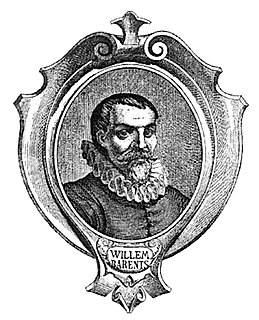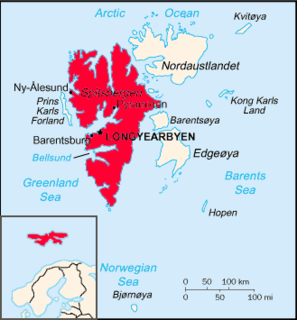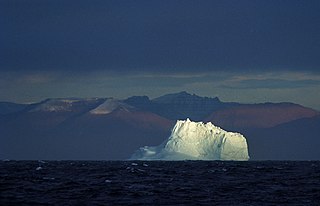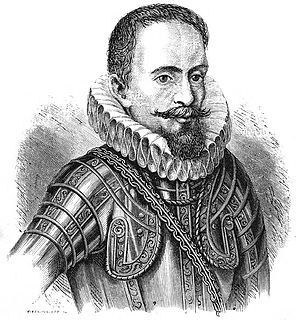
Jan Mayen is a Norwegian volcanic island in the Arctic Ocean, with no permanent population. It is 55 km (34 mi) long (southwest-northeast) and 373 km2 (144 sq mi) in area, partly covered by glaciers. It has two parts: larger northeast Nord-Jan and smaller Sør-Jan, linked by a 2.5 km (1.6 mi) wide isthmus. It lies 600 km (370 mi) northeast of Iceland, 500 km (310 mi) east of central Greenland and 1,000 km (620 mi) west of the North Cape, Norway. The island is mountainous, the highest summit being the Beerenberg volcano in the north. The isthmus is the location of the two largest lakes of the island, Sørlaguna, and Nordlaguna. A third lake is called Ullerenglaguna. Jan Mayen was formed by the Jan Mayen hotspot.

Henry Hudson was an English sea explorer and navigator during the early 17th century, best known for his explorations of present-day Canada and parts of the northeastern United States.

Willem Barentsz, anglicized as William Barents or Barentz, was a Dutch navigator, cartographer, and Arctic explorer.

Spitsbergen is the largest and only permanently populated island of the Svalbard archipelago in northern Norway.

Smeerenburg was a whaling settlement on Amsterdam Island in northwest Svalbard. It was founded by the Danish and Dutch in 1619 as one of Europe's northernmost outposts. With the local bowhead whale population soon decimated and whaling developed into a pelagic industry, Smeerenburg was abandoned about 1660.
The polar archipelago of Svalbard was first discovered by Willem Barentsz in 1596, although there is disputed evidence of use by Pomors or Norsemen. Whaling for bowhead whales started in 1611, dominated by English and Dutch companies, though other countries participated. At that time there was no agreement about sovereignty. Whaling stations, the largest being Smeerenburg, were built during the 17th century, but gradually whaling decreased. Hunting was carried out from the 17th century by Pomors, but from the 19th century it became more dominated by Norwegians.

The Greenland Sea is a body of water that borders Greenland to the west, the Svalbard archipelago to the east, Fram Strait and the Arctic Ocean to the north, and the Norwegian Sea and Iceland to the south. The Greenland Sea is often defined as part of the Arctic Ocean, sometimes as part of the Atlantic Ocean. However, definitions of the Arctic Ocean and its seas tend to be imprecise or arbitrary. In general usage the term "Arctic Ocean" would exclude the Greenland Sea. In oceanographic studies the Greenland Sea is considered part of the Nordic Seas, along with the Norwegian Sea. The Nordic Seas are the main connection between the Arctic and Atlantic oceans and, as such, could be of great significance in a possible shutdown of thermohaline circulation. In oceanography the Arctic Ocean and Nordic Seas are often referred to collectively as the "Arctic Mediterranean Sea", a marginal sea of the Atlantic.
Jan Jacobszoon May van Schellinkhout was a Dutch seafarer and explorer.

Jacob van Heemskerck was a Dutch explorer and admiral.

Whaling in the Netherlands was a centuries-long tradition. The history of Dutch whaling begins with 17th-century exploration of Arctic fishing grounds; and the profitability of whaling in the 18th century drove further growth. Increased competition and political upheavals in Europe affected the stability of this maritime industry in the 19th century; and a combination of these factors cut short any further growth of Dutch whaling in the Antarctic.
Jean Vrolicq was a mariner from St-Jean-de-Luz in the first half of the 17th century. He served in the Danish, Dutch, and French whaling industries from 1619 to 1636, and later became a privateer.

Willem Cornelisz. van Muyden was an early 17th-century mariner. He is known in the Netherlands as De Eerste Walvisvanger (1613). Van Muydenbukta and Van Mijenfjorden on the west coast of Spitsbergen and Kapp Muyen on the west coast of Jan Mayen are named after him.
Lambert van Tweenhuysen was a prominent Lutheran merchant at Amsterdam in the early seventeenth century. Born of a well-known patrician family, he had contacts ranging from Archangel and Spitsbergen to North America, and from Northwest Africa to Istanbul. He traded in a wide variety of items, including salt, corn, wine, wood, linseed, textiles, tar, soap, furs, spices, and pearls. He had trade connections in the Baltic, France, Spain, Portugal and the Mediterranean.
Joris Carolus was a Dutch cartographer and explorer. He served for both the Noordsche Compagnie and the Vereenigde Oost-Indische Compagnie.

Samuel Godin, Godyn or Godijn was a wealthy merchant, originally from Southern Netherlands, trading on Spain, Brazil and the Levant. He was one of the administrators of the Noordsche Compagnie, involved in whaling, and of the Dutch West India Company. From 1620 he traded on New Netherland. His name was at first given to the Delaware Bay and he was one of the main investors in Zwaanendael. The colony did not last very long as it was plundered by Native Americans soon after its founding.
Virgohamna is a small bay on the northern coast of Danes Island, an island off the northwestern coast of Spitsbergen. Spitsbergen and Danes Island are islands of the Svalbard archipelago. The bay is named after SS Virgo, the vessel of Swedish engineer and explorer Salomon August Andrée's 1896 expedition. Virgohamna is located across a small strait from Smeerenburg, a historical whaling station on Amsterdam Island about 2 km to the north.
The Basques were among the first to catch whales commercially, as opposed to aboriginal whaling, and dominated the trade for five centuries, spreading to the far corners of the North Atlantic and even reaching the South Atlantic. The French explorer Samuel de Champlain, when writing about Basque whaling in Terranova, described them as "the cleverest men at this fishing". By the early 17th century, other nations entered the trade in earnest, seeking the Basques as tutors, "for [they] were then the only people who understand whaling", lamented the English explorer Jonas Poole.
Oceanwide Expeditions is a Dutch company specializing in expedition-style voyages to Antarctica and the Arctic. Deploying its own fleet of ice-strengthened vessels, Oceanwide emphasizes small-scale, flexible tours that provide passengers close contact with polar wildlife, landscapes, and historical sites. Tours usually take place in regions only accessible by sea, with little to no infrastructure. The locations visited are first reached by ship, after which expedition guides take small groups of passengers to landing sites by way of Zodiac Milpro RIBs, enabling safe cruising and maximum shore time.
Johan Kjeldsen was a Norwegian skipper. He took part in many Arctic expeditions and is credited with the discovery of Kvitøya.













